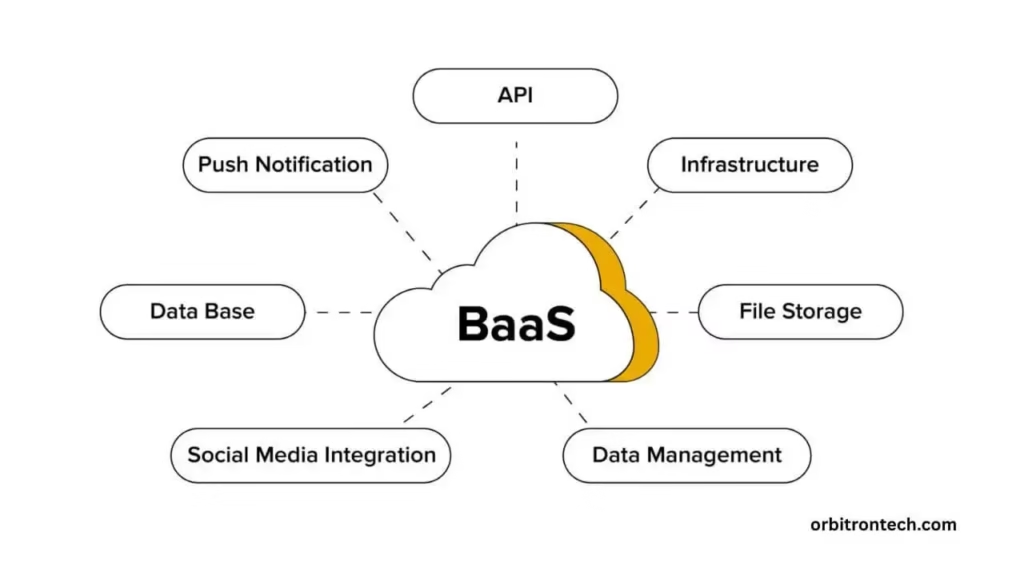What Is Backend as a Service (BaaS)? A Beginner-Friendly Guide
Have you ever come up with a great app idea, a productivity tool, a network platform or a fun mobile experience but have made backend work dreaded? Things such as managing user accounts, securely storing data and handling server infrastructure can be difficult. It is that Backend as a Service (BaaS) comes in rescue.

Well, here’s some good news: you don’t have to do all that yourself. That’s where Backend as a Service (BaaS) comes in. With BaaS, you get a ready-made backend that means database, authentication, file storage and push notifications. All delivered through the cloud. You simply a frontend, hit installation and voilà: your app works.
You can use pre-built services such as Firebase, Supabase, or Appwrite by BaaS providers. These platforms offer plug-and-play tools such as user authentication, real-time databases; file storage and even Serverless functions are accessible through all clean APIs or SDKs.
Why BaaS Is a Game-Changer
Let me share a little anecdote. Last year, a friend of mine, Sarah, built a simple community app in just two weekends. She used Firebase, a popular BaaS, to handle:
- User authentication (so people could log in)
- Data storage (for posts and comments)
- Real-time updates (so chat felt instant)
Rather than spending weeks setting up servers and stressful scaling, she focused on the user experience i.e., skins, icons, emojis. By Monday, she had a working app, shared it with friends, and got valuable feedback. Pretty neat, right?
In comparison, after I built my app, I spent days wrestling with server setup, database schemas, and deployment scripts. Frustrating! That’s why I’m a complete fan of BaaS and it saves time, headaches, and money.
Top Backend as a Service Providers to Consider
Choosing the right Backend as a Service provider is critical for your app’s success. Here’s a more in-depth comparison of the top BaaS platforms with their strengths and ideal use cases.Here are some of the top BaaS platforms:
| Provider | Ideal For | Notable Features | Hosting Type |
| Firebase | MVPs, chat apps, startups | Real-time DB, push notifications, Google Analytics, serverless | Fully Hosted |
| Supabase | SQL apps, open-source fans | PostgreSQL, instant REST & GraphQL APIs, auth, storage | Self or Cloud |
| Appwrite | Privacy-first devs | Email login, storage, functions, real-time database | Self-hosted |
| AWS Amplify | Enterprise-grade solutions | Auth (Cognito), APIs (GraphQL/REST), Lambda, S3, CI/CD | Fully Hosted |
| Backendless | No-code/low-code builders | Visual builder, geolocation, messaging, custom logic | Hosted/Self |
| Directus | Headless CMS users | Dynamic SQL API, customizable UI, role-based access | Self/Cloud |
Each platform has unique strengths. For instance, Firebase excels in real-time chat apps, Supabase for SQL lovers, Amplify for AWS aficionados. Choosing one depends on your app’s needs and your familiarity.
Before picking a provider, ask:
- Does it support your preferred language or framework?
- Can it scale with your traffic and storage needs?
- Does it offer the compliance, security, and support your project requires?
Always compare free plans and check performance before committing to a premium tier.
Backend as a Service vs Serverless vs PaaS
There’s often confusion between BaaS, Serverless, and PaaS (Platform as a Service). Let’s clear that up.
BaaS
- You build only the frontend.
- The backend (auth, storage, notifications) is prebuilt.
- Ideal, fast prototype and lean team for MVP.
Serverless (FaaS – Function as a Service)
- Each function executes independently based on events.
- Great for scalable, event-driven applications.
PaaS
- You build both frontend and backend but install it on a managed platform (e.g., Heroku, Google App Engine).
- Offers more flexibility than BaaS but requires more setup than Serverless.
| Feature | BaaS | Serverless (FaaS) | PaaS |
| Developer Control | Low (Prebuilt backend) | Medium (Write your own functions) | High (Full app control) |
| Setup Complexity | Minimal | Moderate | High |
| Scalability | Included (depends on vendor) | Dynamic per function | Auto or manual |
| Custom Logic | Limited | High (Custom functions) | Full |
| Ideal Use Case | MVPs, apps with standard backend | Event-driven apps, API backends | Enterprise-grade applications |
When Should You Use BaaS?
Choose BaaS if you want:
- 🚀 Accelerate development: Skip backend setup and code directly in advance.
- 💵 Save on costs: No server infrastructure, or backend team.
- 🔄 Rapid prototyping/MVPs: Consider ideas to be rapid and repeat.
- 🌍 Build cross-platform apps: A backend web, iOS supports Android.
Common Challenges & How to Handle Them
Vendor Lock-In
Challenge: You rely on the composition, API and database of a selected platform.
Solution: Plan for portability. Use layers of abstraction or tools supported via multiple platforms (e.g., GraphQL). If needed, switch providers or self-hosted options (like Supabase) later.
Cost Surprises
Challenge: Free/low-cost tiers can lead to unexpected bills if usage spikes.
Solution: Monitor usage. Set alerts. Understand the pricing details (eg, reads/writes, storage, outbound bandwidth).
Custom Logic Limitations
Challenge: If you need fancy logic, server-side workflows may experience harsh.
Solution: Use cloud functions (Firebase, Supabase Edge Functions) or upload server-free layer.
Performance and Latency
Challenge: Data facilities a ways from your users can reason slowdowns.
Solution: Use providers with infrastructure (Firebase, AWS Amplify) or self-host worldwide and optimize with CDNs or edge functions.
How to Choose the Right BaaS for Your App
Choosing an ideal Backend as a Service can be a game-changer or if you choose the wrong then a big setback. So how do you decide?
Start with Your App’s Needs
- Real-Time Features
Do you need live updates or collaborative editing? Look into Firebase or Supabase. - Structured Data Queries
Prefer SQL over NoSQL? Choose Supabase or Directus with PostgreSQL. - Hosting Flexibility
Want to self-host? Go with Appwrite or Supabase. Need full cloud-managed infrastructure? Try Firebase or AWS Amplify. - Security & Compliance
Need GDPR, HIPAA, or ISO compliance? AWS, Azure and some enterprise Firebase plans are certified. - Integration Requirements
Need to connect with 3rd-party API or internal equipment? Choose BaaS with API management, webhook and custom logic support (eg, AWS Amplify or Supabase Edge Functions).
Budgeting Considerations
- Free Tiers: Most vendors have them, but to take care, boundaries can be restrictive.
- Pricing Models: Some charge by API call, by other bandwidth or storage. Read the right print.
Long-Term Support
- Check documentation quality, GitHub stars, community activity, and support channels.
- Ask: How frequently is the platform updated? Is it being actively maintained?
Making the right choice early prevents painful stay later.
The Future of BaaS: Trends to Watch in 2025
The world of Backend as a Service (BaaS) is growing rapidly. With the rise of cloud computing, edge infrastructure, AI, and strict data rules, the BaaS platforms are undergoing a significant change. Here we hope to see in the near future.
AI & Machine Learning Integration
Soon, BaaS providers will go beyond just storage and authentication. Platforms like Firebase and AWS Amplify are already starting to embed machine learning models directly into their ecosystems. This will enable:
- Personalized user experiences
- Predictive analytics
- Real-time fraud detection
Edge Computing
Instead of sending every request on the central server, data and code will run close to users on the network edge. This means rapid apps and reduces delay. Tools such as Supabase Edge Functions and Cloudflare Workers are leading this shift.
Privacy-First BaaS Models
Due to increasing demand for compliance of GDPR, CCPA, and HIPAA, BaaS platforms will prioritize:
- End-to-end encryption
- On-premise deployment options
- Data residency settings
Cross-Platform & Device Integration
Expect BaaS to support IoT devices, wearables, and VR platforms out-of-the-box. The provider will offer SDK for non-traditional app environment, widening the developer horizons.
Industry-Specific BaaS
Emerging areas such as healthcare, finance and logistics require backend services to suit strict regulatory environments. Expect top BaaS providers to dominate these verticals with custom equipment and compliance.
Backend as a Service Examples You Can Learn From
Understanding what is Backend as a Service and how it works in actual -world applications is one of the great approaches to understand its actual potential. Let’s take a look at some practical, real-world Backend as a Service example(s) that demonstrate just how flexible and powerful this model can be.
A Real-Time Chat App Using Firebase
A small development team created a group chat app that included authentication, message history, and real-time messaging using Firebase. Within two weeks, they launched a scalable app without writing backend code.
Task Management App with Supabase
A solo developer built a Kanban board app using Supabase. Thanks to built-in PostgreSQL support, the app had powerful query features and could easily track task assignments, labels, and due dates with row-level security.
Social Media MVP Using Appwrite
A design agency prototyped a niche photo-sharing platform using Appwrite. They enabled user roles, uploaded images to secure storage and handled comments and likes through Appwrite’s API, all within their local environment.
Health Tracker With AWS Amplify
An enterprise healthcare group used AWS Amplify to create a HIPAA-compliant health monitoring app. Amplify is allowed smooth integration with other AWS services such as Cognito (for safe login) and Lambda (for custom logic).
Each of these examples indicates how BaaS solutions reduce the improvement timeline and allow greater awareness on the frontend, UX design, or core business features.
Whether you’re constructing a side hustle or a completely -funded startup, learning from actual BaaS use cases is a amazing way to validate your choice of technology and get ideas for your own task.
What Is Backend as a Service Open-Source?
If you are someone who values transparency, control and flexibility, then you’ve possibly wondered: What is Backend as a Service open-source? Simply put, it is the BaaS model built on open-source technologies, allowing you to host and customize your backend for your personal infrastructure or set up it to the cloud.
Why Open Source?
Most traditional BaaS providers are proprietary. This means that when you get the convenience, you are tied in their specific ecosystem. But open-source BaaS platforms such as Supabase, Appwrite, and Directus give you both the best of the worlds:
- Control: You can inspect, modify or expand the source code.
- Portability: Migrates between clouds – hybrid systems.
- Compliance: Maintain complete data ownership and complete regional laws like GDPR or HIPAA.
Top Open-Source BaaS Options
- Supabase: Offers PostgreSQL, Row-Level Security, Edge Functions, and instant APIs.
- Appwrite: Built with Docker, it supports secure authentication, file storage, and serverless functions.
- Directus: A headless CMS that wraps any SQL database with a real-time API and dynamic data modeling.
These platforms offer effective alternatives for closed-source BaaS, especially for groups that require more freedom and low restrictions. While they require more setup, the trade-off is often worth it for custom logic, data control or open integrations projects.
Therefore, if you want the advantages of BaaS but do not want to hand over your backend to a third party, then it is a smart move to go to open-source.
What Is Backend as a Service Azure?
When companies ask what is Backend as a Service Azure, they’re relating to Microsoft Azure’s suite of managed backend services that mimic or combine with BaaS features, together with authentication, databases, APIs, and serverless functions.
While Microsoft Azure doesn’t offer a single product named “BaaS,” it presents the equipment to build a BaaS architecture:
- Azure Functions: A serverless compute option to run backnd logic on demand.
- Azure Cosmos DB: A globally distributed Nosql database with real -time support.
- Azure App Service: Host web apps and API with Built -in CI/CD and scaling.
- Azure Active Directory B2C: Provides identity and get access to control.
Why Choose Azure for BaaS?
- Enterprise Security: Integrates with Microsoft security stack.
- Hybrid Cloud Ready: Ideal for corporations wanting on-prem and cloud coexistence.
- Compliance: Azure meets a big selection of compliance certifications (GDPR, ISO, SOC, HIPAA).
When to Use It?
Choose Azure as a BaaS in case you’re constructing company -grade applications with strict data regulations, or want deep integration with other Microsoft services like Office 365, Power BI, or Azure DevOps.
Azure isn’t the most beginner-friendly BaaS choice, but it’s fantastically powerful for companies that require scalability, modular control, and enterprise-level capabilities.
What Is Backend as a Service Supabase?
You’ve possibly heard of Supabase in case you’ve been exploring BaaS tools these days. So allows destroy down exactly what is Backend as a Service Supabase, and why it’s rapidly becoming one of the most recommended open-source tools in current app improvement.
What Is Supabase?
Supabase is an open-source Firebase opportunity that’s constructed on PostgreSQL. It turns your SQL database into a real-time backend with:
- Auto-generated REST & GraphQL APIs
- Row-level security
- Authentication with social logins and magic links
- Edge Functions (like Cloud Functions)
- Realtime subscriptions
- File storage and CDN
Why Developers Love Supabase
- SQL Native: You don’t need to learn a new NoSQL format.
- Self-hostable: Use it regionally, on Vercel, Render, or your own cloud.
- Developer-first docs: Excellent tutorials, templates, and integrations.
- No black box: It’s open-source; you spot the entirety underneath the hood.
Supabase is best for teams that want modern-day BaaS competencies but still love traditional SQL logic and control. It’s mainly great for startups building dashboards, admin panels, real-time apps, or even marketplaces.
Whether you are prototyping or scaling, Supabase offers the flexibility and transparency that maximum closed structures can’t.
What Is Backend as a Service GeeksforGeeks?
For many budding developers and computer science students, GeeksforGeeks is the go-to resource for tutorials. So when people search what is Backend as a Service GeeksforGeeks, they’re looking for a trusted educational explanation.
GeeksforGeeks Breakdown of BaaS
According to their guides, BaaS is described as:
“A cloud computing service that provides developers with a way to connect their applications to backend cloud storage and APIs exposed by backend applications while also providing features such as user management, push notifications, and integration with social networking services.”
Key Concepts They Emphasize
- Prebuilt APIs: Great for reducing time to market.
- Authentication: Simplifies login systems across apps.
- Vendor Lock-in Concerns: Encourages developers to consider open-source options like Supabase or Appwrite.
Educational Use Cases
GeeksforGeeks even suggests using Firebase for academic projects, Supabase for SQL-backed apps and Appwrite if you’re learning backend architecture.
For students, learners, and junior developers, their platform allows demystify BaaS fundamentals and gives great code examples in React, Node.js, and Flutter.
Whether you are a CS student constructing your first app or an educator preparing course content, their publications are reliable and easy to understand.
Wrapping It Up
To sum it up: Backend as a Service (BaaS) is the modern magic wand for building apps. Skip the server-room complications, allow someone else manage it, and dive into what users see and love. You gain speed, flexibility, and price-performance, especially for MVPs, prototypes, side projects, or cross-platform apps.
If you’ve got an idea for whatever from a chat app to a pet-sharing community or a productiveness device then start with a BaaS like Firebase, Supabase, or Appwrite. You’ll reduce time-to-launch from months to days, awareness on design and UX, and advantage the self-assurance to deliver rapid.
Conclusion:
So, after deep dive, the question stays: Should you use Backend as a Service (BaaS)?
If your goal is to build apps quicker, save money, avoid server complications, and get to market fast; then yes, absolutely.
From small indie developers to large enterprises, the benefits are hard to ignore:
- Rapid development
- Lower infrastructure costs
- Focus on frontend and UX
- Built-in security and compliance
- Scalability from day one
However, it’s not a silver bullet. Consider:
- Vendor lock-in risks
- Customization limitations
- Compliance concerns for sensitive industries
The smart approach? Start with BaaS, especially for MVPs and v1 releases. Once tested, you could scale, migrate, or combine extra infrastructure as wanted.
With tools like Supabase, Firebase, Appwrite, and AWS Amplify, you’re spoiled for preference. Evaluate based totally in your stack, group size, and price range. You’ll be building, trying out, and scaling very quickly.


